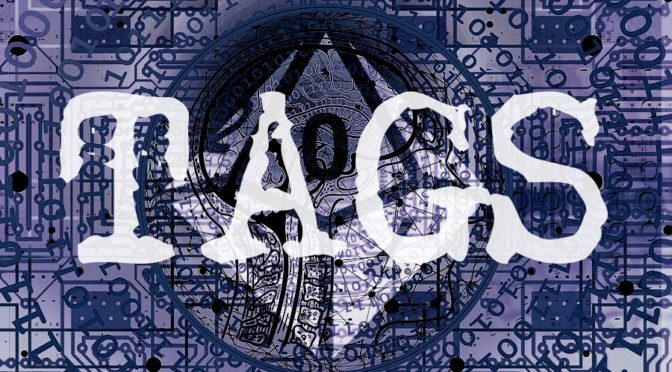
Tags in Drive·10 make up all the cool traits, powers, skills and features a character can have. When I set out to design the framework, I decided that instead of trying to make a large, encompassing list like we’ve done with other games, to instead create a simple guide to how Tags operate at the meta level. I took inspiration from systems like Fate and Savage Worlds in that I wanted someone to easily skin and translate whatever it is they’re wanting for their character into a game mechanic in a moment’s notice.
A quick recap of how Tags function in Drive·10
Although Functions can be simple in theory, they can sometimes be complex in practice — it’s easy to say, “My Wings let me Fly!” or “I can shoot lasers from my eyes” but in game terms WHAT DOES THAT MEAN? The GM and Player will need a dialogue to discuss limitations, based on the themes and scale of the campaign. The GM will need to draw the line between where a standard function and a Powerful Function (one that needs a limitation added to it) exists.
What follows is my default guidelines for what a “standard” Character Function may do in my games:
Powerful Functions are more amped up, and the GM is encouraged to restrict them as they see fit. The easiest way to do so is limit it either per scene (or per episode). There may be other quantifications, such as “between full rests” or by spending a resource of some kind like Mana or Energy.
I’ve been asked about how to arbitrate between labeling a Tag as either an Edge or a Boost. Although the operate differently, they both result in providing a bonus towards succeeding a task. The big thing to remember is that Edges can be advantageous towards several actions, while Boosts were meant to hone a specific action in the form of specialized training or equipment for a task.
In short: take an Edge if you’re wanting to perform better in an particular area or field, take a Boost if you want to be better at a specific action or skillset — especially one tied to your Vocational statement. And by all means, do both!
Running such a free-form, arbitrary system can leave new players feeling overwhelmed when it comes to deciding what kind of Tags they want for their character. One practice I’ve mused on for some time is the approach of “Anchors and Tethers”. In short: use established traits as “anchors” and tether off new ones from them. During character creation, you already have a strong anchor: your core Vocation statement.
There’s a brief mention in the D·10 core that was much longer in the original draft, stating that tags can be linked together. The example I gave was equipment based: a rifle with a high-powered scope. In game terms you could break that down as a Medium-Ranged Attack function (the Rifle) with a Boost (the scope). This can also work for character tags — those Wings of yours establish flight, but you may tether another tag to them, one like Dive Bomb that says you have an Edge when attacking a ground target from above! Or Escalated Speed to give you an Edge in flight-based chases.
All talk of Tags so far has been positive features, but what about “disadvantages” or negative traits? I primarily kept those out of the core because I feel systems that offer the exchange of negative traits for positive ones wind up being gamed for ridiculous builds instead of interesting character developments.
But that said, we’ve always house ruled an exchange of benefits for Setbacks. A Setback is a negative tag, which may or may not have a penalty effect in terms of game mechanics but will always provide an obstacle to the character. Like any other tag, a dialogue between the GM and Player to gauge severity and the degree trade in will be important. Some Setback ideas:
Cybernetic Aversion: Characters in a cyberpunk setting have a hardcore phobia of being augmented, even when it comes to things like nanite treatment for faster healing. Characters with cybernetic aversion may gain two extra Boosts.
Allergic to Silver: A character born of a Werewolf bloodline, who is slowly developing their powers, has inherited the supernatural weakness against Silver. Any weapons or attacks made with pure silver are treated as Heavy damage. These wounds cannot be healed with supernatural healing of any kind. In exchange, the character may take an extra paranormal Tag related to their heritage.
WANTED: Someone, either a powerful individual or organization, wants the character found (and possibly killed). Flyers and advertisements are posted everywhere, and there’s a big reward. The character may be able to function under the radar but it’s a constant nuisance that interferes with the entire party at inopportune times. The GM and Player agree that at any time, the GM can randomly have NPCs recognize the character, or be in a position where they may be in danger because of the wanted status. In exchange, the player may earn a “luck” token from the encounter, which they can use to re-roll after failing an action test.
+++
I hope this article was helpful in the further explanation of Tags, and gave some inspiration on how to approach them in Drive·10. Even if you’re not a fan of the arbitrary nature of the game, you could use this as a framework to create a list of tags appropriate to your campaign.
Remember that the Drive·10 framework is released under Creative Commons BY-SA 4.0, meaning you are free to take these ideas and use them in your own work (so long as you credit us and share alike.)
Haven’t checked DRIVE·10 out yet? Grab it on Itch.io!